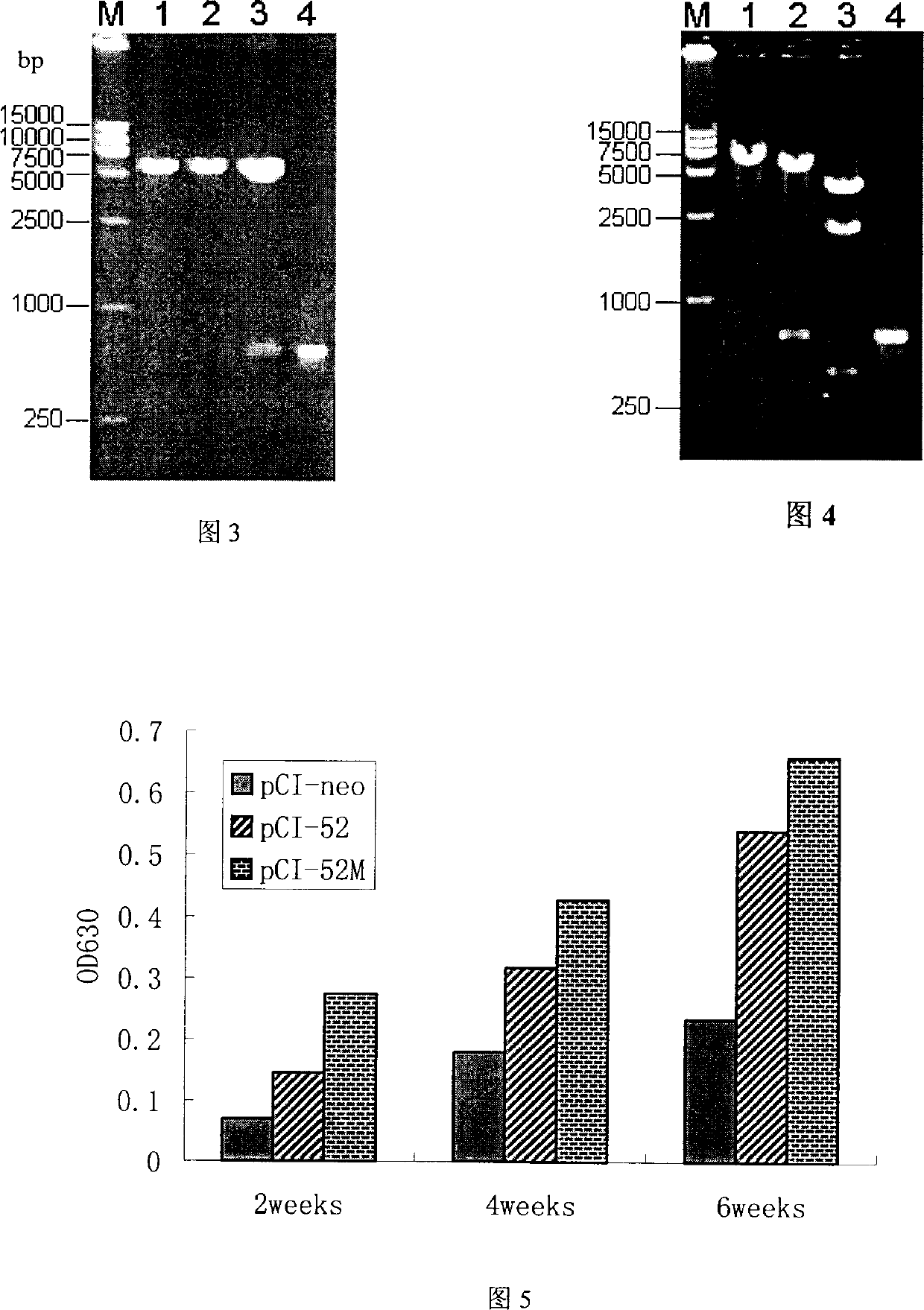Modified pig propagation and respiratory syndrome virus ORF5 gene and use thereof
A technique for respiratory syndrome and pig breeding, applied in application, genetic engineering, virus antigen components, etc., can solve problems such as insufficient exposure of neutralizing epitopes and difficulty in stimulating neutralizing antibodies
- Summary
- Abstract
- Description
- Claims
- Application Information
AI Technical Summary
Problems solved by technology
Method used
Image
Examples
Embodiment 1
[0068] Example 1: Preparation of a plasmid containing the modified gene of the present invention and a plasmid containing a control gene
[0069] 1. Construction of eukaryotic plasmid pCI-52 expressing unmodified ORF5 gene (control)
[0070] Using pMD-ORF5 as a template, P52S and P52R as primers to amplify the ORF5 gene, the purified amplified product was digested with XhoI and XbaI, and cloned directly into the corresponding site of the eukaryotic expression vector pCI-neo to obtain the recombinant plasmid pCI- 52. Its structure is shown in Figure 2, and the results of enzyme digestion and PCR identification are shown in Figure 3 (XhoI and XbaI enzyme digestion only have a band of about 6000bp, XhoI+XbaI enzyme digestion produces a band of about 600bp and a band of about 5400bp, PCR amplified a band of about 600bp).
[0071] 2. Construction of the eukaryotic plasmid pCI-52M expressing the modified ORF5 gene
[0072] Using pMD-ORF5 as a template, use primers p51 and p5m1 to...
Embodiment 2
[0073] Embodiment 2: the biological experiment of DNA vaccine of the present invention and contrast vaccine to immune efficacy of mice
[0074] 1. Immunization procedure of Balb / c mice
[0075] Divide Balb / c mice into 3 groups, 6 mice in each group, and inject 100 μl (containing 100 μg plasmid) into each mouse by intramuscular injection of hind legs, and immunize 2 times with an interval of 2 weeks. As a negative control for nucleic acid immunization. At 2, 4, and 6 weeks after the first immunization, blood was collected through tail vein negative pressure, and the serum was separated to detect ELISA antibody and neutralizing antibody.
[0076] 2. ELISA antibody level
[0077] The GP5 protein expressed and purified by Escherichia coli was used as the antigen to detect the ELISA antibody level in the serum. The results showed that the ELISA antibody induced by the modified DNA vaccine pCI-52M was significantly higher than that of the unmodified DNA vaccine pCI-52M. 52 immune...
Embodiment 3
[0084] Embodiment 3: DNA vaccine of the present invention and control vaccine are to the biological experiment of weaned piglet immune efficacy
[0085] 1. Pig immunization program
[0086] The weaned piglets were randomly divided into 5 groups, 4 pigs in each group, and each pig was injected intramuscularly with 500 μL (containing 100 μg plasmid), and immunized 3 times with an interval of 2 weeks. control. Blood was collected through the anterior vena cava at 6 weeks, 8 weeks, and 10 weeks after the first immunization, and the serum was separated to detect the levels of ELISA antibodies and neutralizing antibodies. At the same time, anticoagulant blood was collected, and lymphocytes were separated to detect the level of cellular immune response.
[0087] 2. ELISA antibody detection
[0088] The GP5 protein expressed and purified by Escherichia coli was used as the antigen to detect the ELISA antibody level in the serum. The results showed that the ELISA antibody induced by ...
PUM
 Login to View More
Login to View More Abstract
Description
Claims
Application Information
 Login to View More
Login to View More - R&D
- Intellectual Property
- Life Sciences
- Materials
- Tech Scout
- Unparalleled Data Quality
- Higher Quality Content
- 60% Fewer Hallucinations
Browse by: Latest US Patents, China's latest patents, Technical Efficacy Thesaurus, Application Domain, Technology Topic, Popular Technical Reports.
© 2025 PatSnap. All rights reserved.Legal|Privacy policy|Modern Slavery Act Transparency Statement|Sitemap|About US| Contact US: help@patsnap.com



